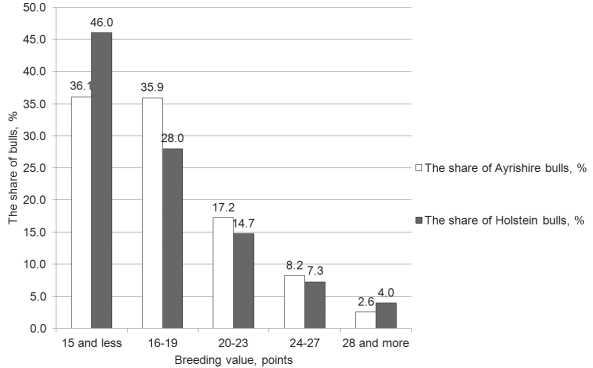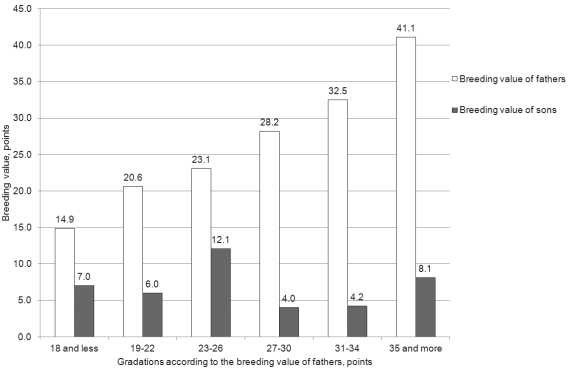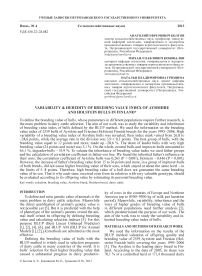Variability & heredity of breeding value index of Ayrshire and Holstein bulls in Finland
Автор: Bolgov A.E., Konovalov M.P., Grishina N.V.
Журнал: Ученые записки Петрозаводского государственного университета @uchzap-petrsu
Рубрика: Сельскохозяйственные науки
Статья в выпуске: 4 (133), 2013 года.
Бесплатный доступ
To define the breeding value of bulls, whose parameters in different populations require further research, is the main problem in dairy cattle selection. The aim of our work was to study the variability and inheritance of breeding value index of bulls defined by the BLUP method. We used the information on the breeding value index of 2559 bulls of Ayrshire and Friesian (Holstein) Finnish breeds for the years 1995-2006. High variability of a breeding value index of Ayrshire bulls was revealed; their index mark varied from 26,8 to -28,6 points, while the average rate in the division was 3,9 ± 0,3 points. The best group of bulls, with the breeding value equal to 12 points and more, made up -28,6 %. The share of leader bulls with very high breeding value (24 points and more) was 3,1 %. On the whole, neutral bulls and improver-bulls amounted to 64,1 %, degrader-bulls - 35,9 %. To valuate the inheritance of breeding value index we used father groups and the calculation of correlation coefficient in father-son line. We found the inherited father’s influence on their sons; the correlation coefficient of Ayrshire bulls was 0,263 (P
Selection, breeding value, ayrshire breed, holstein breed, dairy cattle
Короткий адрес: https://sciup.org/14750434
IDR: 14750434 | УДК: 636.22/.28.082
Текст научной статьи Variability & heredity of breeding value index of Ayrshire and Holstein bulls in Finland
To define and raise genetic value of animals is the main problem in dairy cattle selection. Meanwhile the direct qualification of animal’s genetic value is not possible yet [5]. But it is predicted with the help of phenotype of the animal’s parents or/and the animal itself or/and its offspring by defining breeding value and calculating selection indexes [5]. For this purpose BLUP (Best Linear Unbiased Predictor) [1], [2], [4], [6], and BLUP AM (BLUP for Animal Model) [1], [2], [4] methods are admitted as the most effective.
Defining the breeding value of bulls with the BLUP method is widely used in selection programs of dairy cattle in many countries of the world. It is bulls’ selection for their higher breeding value that caused a substantial progress in dairy productiv- ity of cows in the counties of Europe and Northern America (up to 8500–9500 kg of milk per lactation period). Meanwhile, variability, inheritance and the ways of higher grades of breeding value of bulls in different populations need further analysis [5], which predetermined the purpose of our work. The aim of the work was to study the variability and inherited breeding value index of bulls.
MATERIALS AND METHODS OF RESEARCH WORK
We used the information on the results of the BLUP method valuation of offspring quality and breeding value of 2559 Ayrshire and Friesian (Holstein) Finnish bulls covering the years 1995–2006 [3]. The Ayrshire is the leading dairy breed in Finland. According to the data of 2005, its share was 70,1 % of a controlled herd or 171,4 thousand dairy
cows (the largest population of the Ayrshire breed in the world). The share of Friesian (Holstein) and Finnish breed was 28,8 % and 1,1 % accordingly.
The Finnish Ayrshire cows are able to produce high-quality milk rich in protein and fat. In 2005, the productivity of controlled Ayrshire cows was 8274 kg of milk with protein content equal to 3,44 % and fat content 4,31 %.
To define breeding value of bulls the BLUP method is used, which is constantly improved. The total breeding value is expressed in points and is qualified with the index of productivity, fertility, health, and udder texture of daughters. The total protein output per lactation is assumed as the main selection trait.
In Finland, many other traits are evaluated to have additional information. After the breeding value has been qualified, the bulls are divided into following groups: the best, whose breeding value is 12 points and more (suitable for breeding); improvers, whose breeding value is more than zero point and degraders with the breeding value lower than zero point.
In our work to valuate the variability of breeding value index, the bulls were divided according to their index grade. To valuate the inheritance degree of breeding value we used the method of grouping fathers and correlation in father-son line. Pearson’s correlation coefficient is calculated based on an Excel spreadsheet. The scale of grades in points (in the figures and tables) is calculated on the Basis of the difference between the maximum and minimum values for the sample points divided by the number of groups (grades).
RESEARCH WORK RESULTS AND DISCUSSION
The division of evaluated Ayrshire bulls according to breeding value is shown in table 1. In the whole division, the breeding value of Ayrshire bulls has positive evaluation points (3,9 ± 0,3). This proves that they are breed improvers. 64,1 % of bulls have breeding value equal to zero and more points. 28,6 % of these bulls refer to the best group of bulls whose breeding value is 12 and more points. The share of leader bulls with breeding value of 24 points and more is 3,1 %. The degrader bulls make 35,9 %. These data illustrate high variability of breeding value index of the bulls. Its grade varies within the range from 26,8 to –28,6 points.
Table 1
The division of Ayrshire bulls according to their breeding value (1995–2006)
|
Gradations in breeding value, points |
n |
% |
x ± m |
|
–25 and less |
20 |
1,1 |
–28,6 ± 0,9 |
|
from –24 to –13 |
125 |
6,9 |
–16,6 ± 0,3 |
|
from –12 to –1 |
507 |
27,9 |
–5,5 ± 0,1 |
|
from 0 to 11 |
647 |
35,5 |
5,3 ± 0,1 |
|
from 12 to 23 |
463 |
25,5 |
16,2 ± 0,1 |
|
24 and more |
56 |
3,1 |
26,8 ± 0,4 |
|
in the whole division |
1818 |
100,0 |
3,9 ± 0,3 |
The average breeding value grade for Holstein bulls was also positive in the whole division (3,5 ± 0,4). The bulls of breeding value from 0 and more amounted to 62,5 %. The best group of bulls from these, with breeding value equal to 12 points and more amounted to 26,6 %. The share of degrader bulls made 37,5 %.
The average breeding value of the best qualified bulls (12 points and more) of Ayrshire and Friesian (Holstein) breeds was practically similar and made 17,7 ± 0,2 and 17,2 ± 0,4 points accordingly. The division of their breeding value expressed in points is given in аig. 1.
The most part of the bull herd has the breeding value from 12 to 19 points. Their share in Ayrshire and Holstein breed made 72 and 74 % accordingly. The share of the best-qualified leader-bulls (28 points and more) was 2,6 and 4,0 % accordingly.

Fig. 1. The distribution of the best-qualified Ayrshire and Holstein bulls according to their breeding value (12 points and more) in Finland
Therefore, the BLUP estimation determines similar distribution of two different bull breeds in accordance with their breeding value.
In order to study the inheritance degree of breeding value the bulls were divided into father-son pairs. The father’s influence on their sons was tested with the method of grouping and calculation of correlation index. Table 2 shows information on the influence of breeding value of Ayrshire father-bulls on the breeding value of their sons in the whole division.
It is found that bulls inherit the breeding value, although father-son correlation index in the whole division is not high and it is equal to 0,263 (P < 0,001). We should note the specific features of fathers’ hereditary influence connected with their breeding value level. In particular, the degrader bulls (with negative marks) gave offspring of degrader sons as well. Moreover, while negative qualification grade of fathers’ breeding value became lower, their sons showed lower negative qualification marks as well. It is with the decreased qualification grade of fathers from –30,4 to –12,9 that the grade of their sons decreased from –18,2 to –2,2. The bulls, close to neutral breeding status (0,3), produced their sons with nearly the same specific feature (1,2). Moreover, the
Table 2
The breeding value influence of Ayrshire father-bulls on their sons’ breeding value (the whole division)
|
Gradations in breeding value of fathers, points |
n |
Fathers |
Sons |
x ± m |
|
x ± m |
x ± m |
|||
|
-22 and less |
15 |
-30,4 ± 1,3 |
-18,5 ± 2,5*** |
0,131 ± 0,275 |
|
from -21 to -9 |
13 |
-12,9 ± 0,6 |
-2,2 ± 4,0* |
0,147 ± 0,298 |
|
from -8 to 4 |
90 |
0,3 ± 0,3 |
1,2 ± 1,0 |
0,373 ± 0,099*** |
|
from 5 to 17 |
183 |
14,8 ± 0,2 |
6,0 ± 0,7*** |
0,234 ± 0,072** |
|
from 18 to 30 |
531 |
23,7 ± 0,1 |
6,6 ± 0,5*** |
0,012 ± 0,043 |
|
31 and more |
141 |
34,4 ± 1,4 |
5,4 ± 0,8*** |
0,002 ± 0,085 |
|
in the whole division |
973 |
20,1 ± 0,4 |
5,3 ± 0,3*** |
0,263 ± 0,031*** |
Notes. * P < 0,05; ** P < 0,01; *** P < 0,001.
hereditary influence of fathers on their sons was the highest in comparison with father groups of another breeding status, for father-son correlation index was the highest here (0,373 P < 0,001). What concerns improver-bulls , the growth of father’s breeding value (from 14,8 to 34,4 points) did not result in higher breeding value of their sons. It kept nearly the same level – from 5,4 to 6,6 points. We have reason to speak about regression, which is marked by the fact that the most valued improver - bulls do not always produce their sons of the most valuable breed. This fact is also proved by the absence of father-son correlation connection in two gradation groups with the highest breeding value of fathers (r = 0,012; 0,002).
Nearly the same inheritance character of breeding value was found in the tested population of Holstein bulls (495 father-son pairs) but with specific feature – hereditary influence of fathers was on the whole significantly higher (r = 0,446 ± 0,040; P < 0,001), than the one in the Ayrshire breed.
Specific feature found in the Ayrshire bulls was proved: the degrader-fathers gave mainly degrader-sons, while neutral bulls, as a rule, reproduced their breeding status in their son’s progeny. The process of regression appeared in this population as well: while father’s breeding value grade grew from 10,6 to 34,8 points, the son’s grade did not practically change and it was limited within 4,8 to 7,6 points.
Nevertheless, the materials on both bull populations really show that the sons of father - improvers inherit their breeding qualities, they are also improvers, although not as highly qualified as their fathers are.
These results are proved by the data of other research workers. The higher were the father-bulls evaluated, the better was the average index of their sons, and the more was the percentage of improvers among them (A. Ermilov, 1986) (citing from [4; 87]).
In addition to the above mentioned analysis covering the whole bull population, we have studied the inherited character of breeding value of bulls from the best part of population recommended for breeding practice (12 points and more).
The degree of inherit influence of Ayrshire breed fathers in this division was significantly lower than the one in the whole population (fig. 2). While the breeding value of fathers grew from 16,7 to 36,2 points, this index of their sons significantly lowered from 7,7 to 5,4 points (P < 0,005).

Fig. 2. The breeding value of fathers and sons of the Ayrshire breed (father-improvers with breeding value of 12 points and more)
The calculated correlation indexes in father-son pairs prove these specific traits. In particular, the relation in the division was practically absent (–0,042 < 0,035); in some bull gradations, it was of contradictory character (from –0,226 < 0,104 to 0,367 < 0,132).
The same specific features were found for the Holstein breed bulls (fig. 3). While the breeding value of fathers grew from 14,9 to 41,1 points, this index of their sons did not grow. It varied in different gradations within 4,0 and 12,1 points. The father-son correlation link was absent both in all separate taken gradations and in the whole division (–0,014 ± 0,065).

Fig. 3. The breeding value of fathers and sons of Holstein bulls (father-improvers with breeding value of 12 points and more)
These materials show that high breeding value of a bull does not guarantee the same high breeding value of its son, which should be tested complexly and be qualified to prove factual breeding data.
Further progress of Ayrshire breed is possible if we use every new bull generation of better breeding values than the previous generation. It assumes the necessity to estimate every young bull, even an offspring of its relatives with very valuable genotype.
CONCLUSION
Our research work showed that preliminary selection in father line raises average breeding value of their sons, but it does not always guarantee effec- tive improvers in the next generation. Perhaps these deviations are caused by plenty of characteristics included in the complex index – productivity index, exterior, udder texture, health and others [7] has the same opinion. To provide genetic progress in a herd it is not enough to import world-level leader bulls from abroad or to use imported sperm of these leaders. In any case, it is necessary to evaluate young bulls in their offspring quality to select the best. Only the valuation of offspring quality can show highly valuable sires.
* Работа выполнена при поддержке Программы стратегического развития ПетрГУ в рамках реализации комплекса мероприятий по развитию научно-исследовательской деятельности на 2012–2016 гг.
Bolgov A. E., Petrozavodsk State University (Petrozavodsk, Russian Federation)
Konovalov M. P., Petrozavodsk State University (Petrozavodsk, Russian Federation)
Grishina N. V., Petrozavodsk State University (Petrozavodsk, Russian Federation)
OF AYRSHIRE AND HOLSTEIN BULLS IN FINLAND


